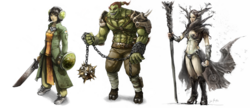James Paul Blaylock is an American fantasy author. He is noted for a distinctive, humorous style, as well as being one of the pioneers of the steampunk genre of science fiction. Blaylock has cited Jules Verne, H. G. Wells, Robert Louis Stevenson, Arthur Conan Doyle and Charles Dickens as his inspirations.

Steampunk is a subgenre of science fiction that incorporates retrofuturistic technology and aesthetics inspired by 19th-century industrial steam-powered machinery. Steampunk works are often set in an alternative history of the Victorian era or the American "Wild West", where steam power remains in mainstream use, or in a fantasy world that similarly employs steam power.
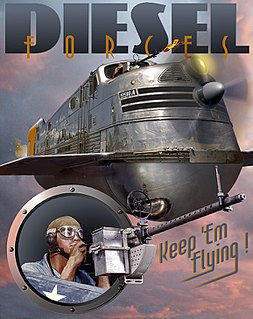
Retrofuturism is a movement in the creative arts showing the influence of depictions of the future produced in an earlier era. If futurism is sometimes called a "science" bent on anticipating what will come, retrofuturism is the remembering of that anticipation. Characterized by a blend of old-fashioned "retro styles" with futuristic technology, retrofuturism explores the themes of tension between past and future, and between the alienating and empowering effects of technology. Primarily reflected in artistic creations and modified technologies that realize the imagined artifacts of its parallel reality, retrofuturism can be seen as "an animating perspective on the world".
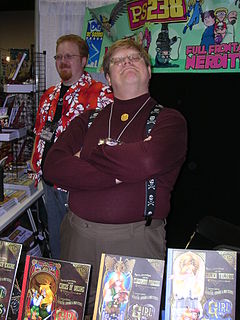
Philip Foglio is an American cartoonist and comic book artist known for his humorous science fiction and fantasy art.

A campaign setting is usually a fictional world which serves as a setting for a role-playing game or wargame campaign. A campaign is a series of individual adventures, and a campaign setting is the world in which such adventures and campaigns take place. Usually a campaign setting is designed for a specific game or a specific genre of game. There are numerous campaign settings available both in print and online. In addition to published campaign settings available for purchase, many game masters create their own settings, often referred to as "homebrew" settings or worlds.
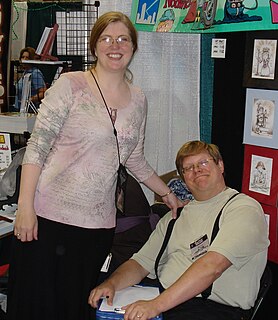
Kaja Foglio is a Seattle-based writer, artist, and publisher. Foglio co-won the first Hugo Award for Best Graphic Story in 2009 for Girl Genius, Volume 8: Agatha Heterodyne and the Chapel of Bones, a series which went on to win two more Hugo Awards.
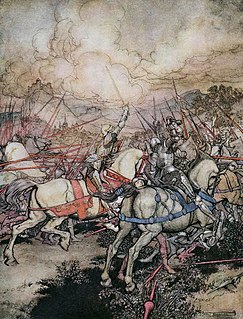
Historical fantasy is a category of fantasy and genre of historical fiction that incorporates fantastic elements into a more "realistic" narrative. There is much crossover with other subgenres of fantasy; those classed as Arthurian, Celtic, or Dark Ages could just as easily be placed in historical fantasy. Stories fitting this classification generally take place prior to the 20th century.
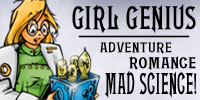
Girl Genius is an ongoing comic book series turned webcomic, written and drawn by Phil and Kaja Foglio and published by their company Studio Foglio LLC under the imprint Airship Entertainment. The comic won the Hugo Award for Best Graphic Story three times, has been nominated for a Hugo Award for Best Professional Artist and twice for Eisner Awards, and won multiple WCCA awards.

Dark fantasy is a subgenre of fantasy literary, artistic, and cinematic works that incorporate disturbing and frightening themes of fantasy. It often combines fantasy with elements of horror or has a gloomy dark tone or a sense of horror and dread.
Since the advent of the cyberpunk genre, a number of derivatives of cyberpunk have become recognized in their own right as distinct subgenres in speculative fiction, especially in science fiction.

The fantasy of manners, sometimes referred to as mannerpunk, is a subgenre of fantasy literature that also partakes of the nature of a comedy of manners. Such works generally take place in an urban setting and within the confines of a fairly elaborate, and almost always hierarchical, social structure. The term was first used in print by science fiction critic Donald G. Keller in an article, The Manner of Fantasy, in the April 1991 issue of The New York Review of Science Fiction; author Ellen Kushner has said that she suggested the term to Keller.

Weird West is a term used for the hybrid genres of fantasy Western, horror Western and science fiction Western. The term originated with DC's Weird Western Tales in 1972, but the idea is older as the genres have been blended since the 1930s, possibly earlier, in B-movie Westerns, comic books, movie serials and pulp magazines. Individually, the hybrid genres combine elements of the Western genre with those of fantasy, horror and science fiction respectively.
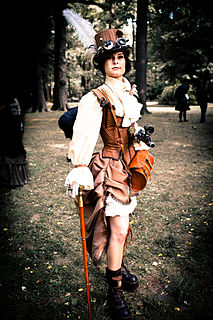
Steampunk fashion is a subgenre of the steampunk movement in science fiction. It is a mixture of the Victorian era's romantic view of science in literature and elements from the Industrial Revolution in Europe during the 1800s. The fashion is designed with a post-apocalyptic era in mind. Steampunk fashion consists of clothing, hairstyling, jewellery, body modification and make-up. More modern ideals of steampunk can include t-shirts with a variety of designs or the humble jeans being accessorised with belts and gun holsters.
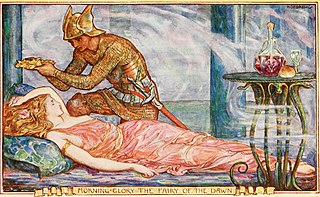
Fantasy is a genre of speculative fiction involving magical elements, typically set in a fictional universe and sometimes inspired by mythology and folklore. Its roots are in oral traditions, which then became fantasy literature and drama. From the twentieth century, it has expanded further into various media, including film, television, graphic novels, manga, animations and video games.

Dieselpunk is a retrofuturistic subgenre of science fiction similar to steampunk or cyberpunk that combines the aesthetics of the diesel-based technology of the interwar period through to the 1950s with retro-futuristic technology and postmodern sensibilities. Coined in 2001 by game designer Lewis Pollak to describe his tabletop role-playing game Children of the Sun, the term has since been applied to a variety of visual art, music, motion pictures, fiction, and engineering.

The following outline is provided as an overview of and topical guide to science fiction:

Solarpunk is a science fiction literary subgenre and art movement that envisions how the future might look if humanity succeeded in solving major contemporary challenges with an emphasis on sustainability, human impact on the environment, and addressing climate change and pollution. Especially as a subgenre, it is aligned with cyberpunk derivatives, and may borrow elements from utopian and fantasy genres.

The type of romance considered here is mainly the genre of novel defined by the novelist Walter Scott as "a fictitious narrative in prose or verse; the interest of which turns upon marvellous and uncommon incidents", in contrast to mainstream novels which realistically depict the state of a society. These works frequently, but not exclusively, take the form of the historical novel. Scott's novels are also frequently described as historical romances, and Northrop Frye suggested "the general principle that most 'historical novels' are romances". Scott describes romance as a "kindred term", and many European languages do not distinguish between romance and novel: "a novel is le roman, der Roman, il romanzo".

